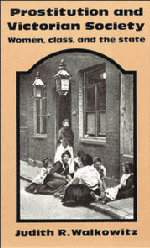Book contents
- Frontmatter
- Contents
- Preface
- Introduction: The Revolt of the Women
- Part I Prostitution, Social Science, and Venereal Disease
- 1 The Common Prostitute in Victorian Britain
- 2 Social Science and the Great Social Evil
- 3 Venereal Disease
- Part II The Contagious Diseases Acts, Regulationists, and Repealers
- Part III Two Case Studies: Plymouth and Southampton Under the Contagious Diseases Acts
- Epilog
- Notes
- Selected Bibliography
- Index
2 - Social Science and the Great Social Evil
Published online by Cambridge University Press: 01 June 2011
- Frontmatter
- Contents
- Preface
- Introduction: The Revolt of the Women
- Part I Prostitution, Social Science, and Venereal Disease
- 1 The Common Prostitute in Victorian Britain
- 2 Social Science and the Great Social Evil
- 3 Venereal Disease
- Part II The Contagious Diseases Acts, Regulationists, and Repealers
- Part III Two Case Studies: Plymouth and Southampton Under the Contagious Diseases Acts
- Epilog
- Notes
- Selected Bibliography
- Index
Summary
An object of fascination and disgust, the prostitute was ingrained in public consciousness as a highly visible symbol of the social dislocation attendant upon the new industrial era. By the 1850s prostitution had become “the Great Social Evil,” not simply an affront to morality, but a vital aspect of the social economy as well. Commentaries on prostitution took a variety of forms: novels, manifestos, letters to the editor, and police reports. Embedded in bluebooks on overcrowding, workhouse children, factory conditions, and women's employment were obligatory references to the immorality consequent upon deleterious social conditions. In addition to this public outpouring of concern, recently published diaries of such men as A. J. Munby and W. E. Gladstone reveal the degree to which prostitution constituted a private obsession for some respectable Victorians, or as Gladstone put it, “the chief burden of my soul.”
The early-Victorian period also witnessed the elaboration of a new style of social research into prostitution and the formulation of activist programs for its amelioration. The intensity of concern, the style of analysis, the special emphasis on empirical and statistical research are all reflections of this particular moment in British political and cultural history. These early investigations deserve special attention for two reasons. They represent perhaps the most systematic efforts in the 1840s to examine the problem – formally proceeding from an examination of causes to results, extent, and remedies for prostitution.
- Type
- Chapter
- Information
- Prostitution and Victorian SocietyWomen, Class, and the State, pp. 32 - 47Publisher: Cambridge University PressPrint publication year: 1980



